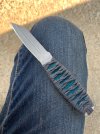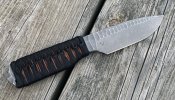fitzo
Gold Member
- Joined
- Aug 14, 2001
- Messages
- 6,648
Thanks Mike,
Opticon is a very useful resin. It can stabile fossils and cracked ivory nicely, as well as gemstones and materials with inherent cracks.
My preferred resin for paracord is Clear Coat by System Three. It is low viscosity and penetrates well. A 12oz. kit is around $45USD.
Opticon is a bit hard to get the ratio right with 10 drops A and 1 drop B. Most folks use 8:1 ratio, to assure full catalyzation. Ounce for ounce it is about the same cost as Clear Coat, but I think the System Three epoxy is a better material for paracord handles.
Be aware that Opticon has a limited shelf life and may not cure right ... or go solid in the can ... beyond 24 months from the manufacture date. I have seen and heard of people being shipped cans that were many years old from suppliers that have slow turnover and from online second sellers who buy up the out-of-date stock from places that are dumping it and sell it on eBay, etc.
They say it can be restored by warming the can in a pot of hot water, but I have not tried that. Just like crystalized honey can be heated and made liquid again, it is not chemically the same after re-liquidation, I suspect the resin has changed, too.
System Three and West System resins have an almost infinite shelf life if stored at proper temperatures.
NOTE:
Having a vacuum chamber helps a lot with deep penetration with things like Opticon when filling cracks.
Thanks, Stacy! I knew a jeweler and lapidary had to know more about Opticon than I did. Good comparison and case for Clear Coat. I remembered Opticon from using it many years ago, but that was years ago, and the viscosity and penetration came to mind, so...
Thanks, again!


